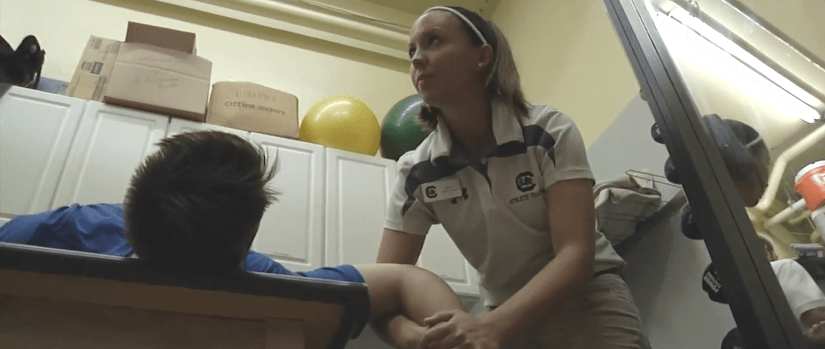July 11, 2016 | Erin Bluvas, bluvase@sc.edu
Starting July 1, 2016, athletic training began its transition from the College of Education to join the Arnold School’s Department of Exercise Science. In addition to a shared history and many overlapping areas between the two programs, the move will help athletic training proactively meet changing accreditation requirements.
Twenty-seven years ago the then-College of Health included both the School of Public Health and the Department of Physical Education. In 1989, several faculty members left physical education to establish the Department of Exercise Science which was incorporated into the School of Public Health. A year later, physical education moved to the College of Education and eventually established the athletic training program. Since 1990, exercise science and athletic training have developed independently yet they have always shared significant overlap in their disciplines (e.g., course content, career opportunities, areas of research).
Athletic training has evolved to include a popular bachelor’s degree program with 200 students and a large master of science program with just over 40 students. They have six full-time faculty members and maintain an enviable student ratio of 16:1 in major-specific courses. The program also pairs students with faculty members and certified athletic trainers at facilities (e.g., Palmetto Health, local high schools, USC athletics, etc.) throughout the Columbia, S.C. area and across the U.S. to provide students with intensive clinical experiences that build on their coursework, preparing them for careers as athletic trainers within professional sports, college, high school, performing arts, military, youth sports and private practice settings.
Meanwhile, the EXSC department has grown from six original faculty members to over 25. Enrollment for their bachelor of science program totals over 1,200 students, and their graduate programs (i.e., M.S., Ph.D. in EXSC; MPH-PAPH; DPT) add another 150. Research expertise has expanded to include preventing muscle wasting with disease, rehabilitation from stroke, and strategies to increase physical activity in diverse populations, ranging from kids to older adults.
Recent changes to athletic training’s accrediting agency, the Commission on Accreditation of Athletic Training Education (CAATE), have led leaders at the University and College/School level to determine that transitioning the athletic training program over to EXSC will yield benefits for all involved. CAATE, through which the athletic training program has maintained accreditation since 1992, previously accredited bachelor-level programs. With their next accreditation cycle, only master’s- and doctorate-level programs can be accredited. They’ve also introduced additional requirements that will need to be incorporated into the existing athletic training master’s-level program.
“The interest in sports medicine and athletic training has grown tremendously, and it’s not just with college athletics, but it has become a critical component with youth settings as well. The breadth of expertise has also expanded to include everything from injuries to MRSA outbreaks,” says James Carson, chair of the EXSC department. “We’re really excited to reunite with athletic training, where we have a lot of overlap, and be a part of this important and growing field.”
Faculty from the athletic training program agree. “For many years students have bounced back and forth between exercise science and athletic training, not really understanding the differences between the degrees and which program would be best for meeting their professional goals—or even why the two programs exist in different departments,” says Jim Mensch, clinical associate professor and undergraduate athletic training program director. “Now, all of these students will be in the same School and department, learning more about about their options for post-baccalaureate degrees and professions in healthcare.”
“We are excited about the opportunity to join the Arnold School of Public Health and the Department of Exercise Science, which will provide faculty and students an opportunity to engage in interprofessional education (e.g., with the physical therapy, exercise science, and publich health programs), improving not only our students’ education but the quality of patient-centered care as well,” says Toni Torres-McGehee, Associate Professor and Graduate Athletic Training Program Director. “In addition, most of our athletic training faculty have terminal degrees in exercise science or kinesiology, so it will be great a opportunity to blend our sports medicine and exercise science expertise with the current faculty and students.”
The EXSC department has experience with helping programs transform from an accredited bachelor program framework into one that requires a clinical/professional graduate-level program in order to meet new accreditation requirements. In 2004, the physical therapy program completed a similar transition to meet the updated requirements of their accrediting agency, the Commission on Accreditation in Physical Therapy Education. Their 3 1/3 year Doctorate in Physical Therapy program is among the best in the nation, with over 700 applicants each year for less than 20 highly competitive spots with 100 percent graduation and employment rates.
“Due to accreditation and teaching requirements, clinical-oriented programs can find conducting novel, impactful research challenging,” says Carson. “But we believe that the modified athletic training graduate degree, combined with our department’s existing research environment, could become a national model for this type of program.”
Alignment with allied health professions is another new change that CAATE has included in its latest accreditation requirements. “There’s already a connection between athletic training and exercise science—both in teaching content and research,” says Carson. “We collaborate on several overlapping research areas and there’s potential for more synergy both within the department, such as concussions and heat stress, and across the School—for example, by working with environmental health sciences in the topic areas of bacterial contamination and locker room surface waters.”
While faculty and staff are looking forward to the changes ahead that will add value to both athletic training and the Arnold School/exercise science, their current priority is to ensure that students understand the upcoming changes and how they may be affected. Current and prospective students and their parents are encouraged to view the athletic training program’s accreditation updates regularly and contact athletic training program directors if they have any questions or concerns.
